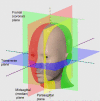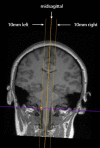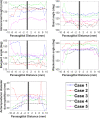The importance of precise plane selection for female adult Chiari Type I malformation midsagittal morphometrics
- PMID: 35947605
- PMCID: PMC9365159
- DOI: 10.1371/journal.pone.0272725
The importance of precise plane selection for female adult Chiari Type I malformation midsagittal morphometrics
Abstract
Introduction: Morphometric assessment of Chiari malformation type I (CMI) is typically performed on a midsagittal MRI. However, errors arising from an imprecise selection of the midsagittal plane are unknown. We define absolute parasagittal error as the absolute difference between morphometric measurements at the midsagittal and parasagittal planes. Our objective was to determine the absolute parasagittal error at various lateral distances for morphometric parameters commonly used in CMI research.
Methods: Sagittal T1-weighted MRI scans of 30 CMI adult female subjects were included. Image sets were evaluated to assess 14 CMI morphometric parameters in the midsagittal plane and four parasagittal planes located 1 and 2 mm lateral (left and right). Comparisons between measurements at the midsagittal and parasagittal planes were conducted to determine the mean individual absolute and mean group parasagittal errors for all 14 parameters.
Results: The mean individual absolute parasagittal error was > 1 unit (1 mm for lengths and 1 degree for angles) for 9/14 parameters within a lateral distance of 2 mm. No significant group parasagittal errors were seen in 14/14 parameters, including tonsillar position within a lateral distance of 2 mm.
Conclusion: Our results show that the absolute errors for imprecise midsagittal plane selection may impact the clinical assessment of an individual patient. However, the impact on group measurements, such as in a research setting, will be minimal.
Conflict of interest statement
The authors have declared that no competing interests exist.
Figures







Similar articles
-
Diagnostic utility of parasagittal measurements of tonsillar herniation in Chiari I malformation.Neuroradiol J. 2022 Apr;35(2):233-239. doi: 10.1177/19714009211041524. Epub 2021 Aug 24. Neuroradiol J. 2022. PMID: 34428087 Free PMC article.
-
Are Two-Dimensional Morphometric Measures Reflective of Disease Severity in Adult Chiari I Malformation?World Neurosurg. 2022 Jan;157:e497-e505. doi: 10.1016/j.wneu.2021.10.138. Epub 2021 Oct 25. World Neurosurg. 2022. PMID: 34710575 Free PMC article.
-
Evidence for sex differences in morphological abnormalities in type I Chiari malformation.Neuroradiol J. 2019 Dec;32(6):458-466. doi: 10.1177/1971400919857212. Epub 2019 Jun 18. Neuroradiol J. 2019. PMID: 31210559 Free PMC article.
-
Headache in Chiari Malformation.Neuroimaging Clin N Am. 2019 May;29(2):243-253. doi: 10.1016/j.nic.2019.01.005. Epub 2019 Feb 20. Neuroimaging Clin N Am. 2019. PMID: 30926114 Review.
-
Is there a morphometric cause of Chiari malformation type I? Analysis of existing literature.Neurosurg Rev. 2022 Feb;45(1):263-273. doi: 10.1007/s10143-021-01592-4. Epub 2021 Jul 13. Neurosurg Rev. 2022. PMID: 34254195 Review.
Cited by
-
The Effect of Posterior Fossa Decompression Surgery on Brainstem and Cervical Spinal Cord Dimensions in Adults with Chiari Malformation Type 1.World Neurosurg. 2023 Dec;180:149-154.e2. doi: 10.1016/j.wneu.2023.09.112. Epub 2023 Oct 1. World Neurosurg. 2023. PMID: 37783305 Free PMC article.
-
Geometric morphometric analysis of the brainstem and cerebellum in Chiari I malformation.Front Neuroanat. 2024 Aug 7;18:1434017. doi: 10.3389/fnana.2024.1434017. eCollection 2024. Front Neuroanat. 2024. PMID: 39170851 Free PMC article.
-
Research process, recap, and prediction of Chiari malformation based on bicentennial history of nomenclature and terms misuse.Neurosurg Rev. 2023 Nov 29;46(1):316. doi: 10.1007/s10143-023-02207-w. Neurosurg Rev. 2023. PMID: 38030943 Review.
References
Publication types
MeSH terms
Grants and funding
LinkOut - more resources
Full Text Sources
Medical

